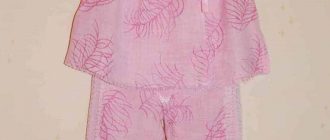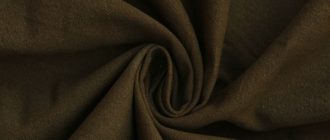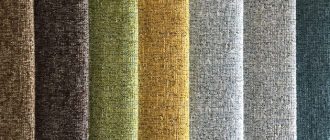Historical Context
The Journey of Cotton
Cotton’s history is as rich and textured as the fabric itself.
Originating in the Indus Valley around 5000 BCE, it spread to Egypt and Europe, becoming a highly sought-after commodity.
The invention of the cotton gin by Eli Whitney in 1793 revolutionized cotton production, making it easier to separate the cotton fibers from the seeds.
This invention led to a boom in cotton farming, particularly in the southern United States.
Today, the global leaders in cotton production are the United States, China, and India, each contributing significantly to the textile industry.
“Cotton is the fabric of our lives.”
The Rise of Polyester
Polyester, a synthetic fiber, was invented in 1941 by British chemists John Rex Whinfield and James Tennant Dickson.
The fiber gained massive popularity in the 1960s and ’70s, especially for its use in fashion.
Polyester offered something unique: it was wrinkle-resistant, durable, and affordable.
Fast forward to today, and polyester is the most used fiber globally, accounting for about 52% of global fiber production.
It’s used in various applications beyond clothing, including industrial materials and home furnishings.
“Polyester may be the anti-hero of fabrics, but it’s the hero we need.”
First-hand Example
A recent visit to a cotton farm in Texas and a polyester manufacturing unit in China offered a first-hand look at the contrasting worlds of these two fibers.
Cotton farming is a labor-intensive process that requires a lot of human touch, from planting to harvesting.
On the other hand, polyester production is a highly industrialized process involving complex chemical reactions and machinery.
These two fibers couldn’t be more different in their production methods, representing the dichotomy of natural vs. synthetic in the textile industry.

The Science Behind the Fibers
The Chemistry of Cotton
Cotton is primarily composed of cellulose, a complex carbohydrate that forms the structure of many plants.
The molecular arrangement of cellulose in cotton allows for hydrogen bonding, which is why cotton can absorb up to 27 times its weight in water.
This makes cotton highly breathable and comfortable against the skin.
However, this absorbency also has a downside: cotton is highly susceptible to stains.
Special treatments and blends are often used to make cotton more stain-resistant, but its natural tendency is to soak up liquids.
“Cotton’s comfort is in its chemistry.”
The Engineering of Polyester
Polyester is a synthetic fiber made from petroleum-based products.
The production process involves polymerization, a chemical reaction that forms the polymer’s structure.
This structure gives polyester its unique properties: incredibly durable, resistant to environmental conditions like moisture and sunlight, and doesn’t wrinkle easily.
However, this durability comes at a cost: polyester is not biodegradable and can be less breathable than natural fibers like cotton.
“Polyester: Engineered for endurance.”
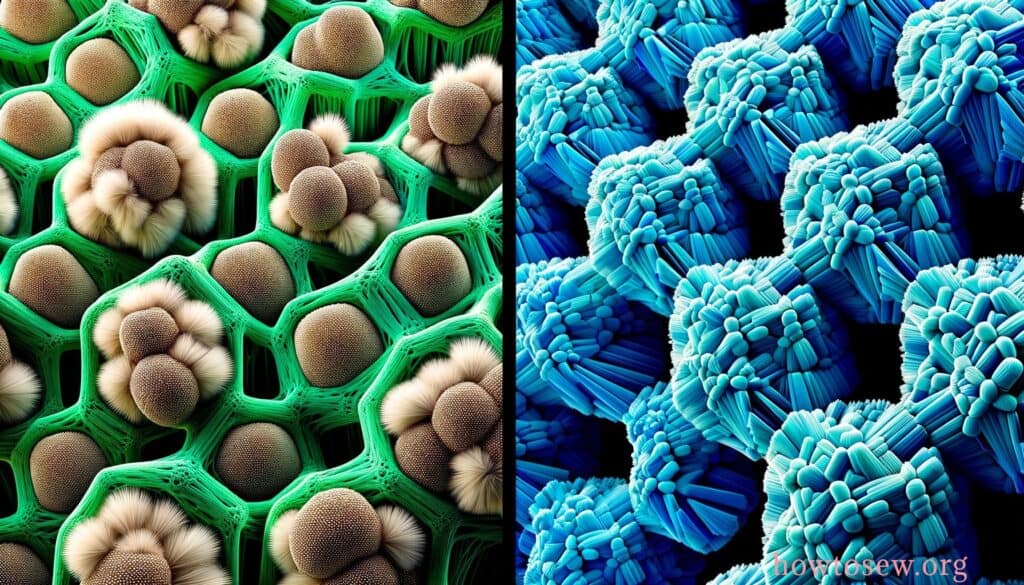
First-hand Example
During an interview with a textile chemist, the intricacies of cotton and polyester were discussed in depth.
Cotton’s molecular structure allows for hydrogen bonding, which gives it its absorbent properties.
Conversely, polyester has a much tighter molecular structure, making it water-resistant but less breathable.
This scientific insight explains why cotton is preferred for hot climates and casual wear, while polyester is often chosen for sportswear and outdoor gear.
Physical and Chemical Properties
Cotton
Cotton is a fascinating material with its physical and chemical properties.
One of its most notable features is its porosity, which makes it highly breathable.
This is why cotton is often the go-to fabric for summer clothing.
The porous nature of cotton also allows for good thermal properties.
It can keep you warm in winter and cool in summer, making it a versatile choice for different climates.
Another aspect to consider is cotton’s tendency to shrink.
While pre-shrunk cotton is available, untreated cotton can shrink up to 5% when washed.
This is something to keep in mind when buying 100% cotton garments.
Additionally, cotton is prone to wrinkling, so it may require regular ironing to keep it looking its best.
“Cotton breathes, just like we do.”
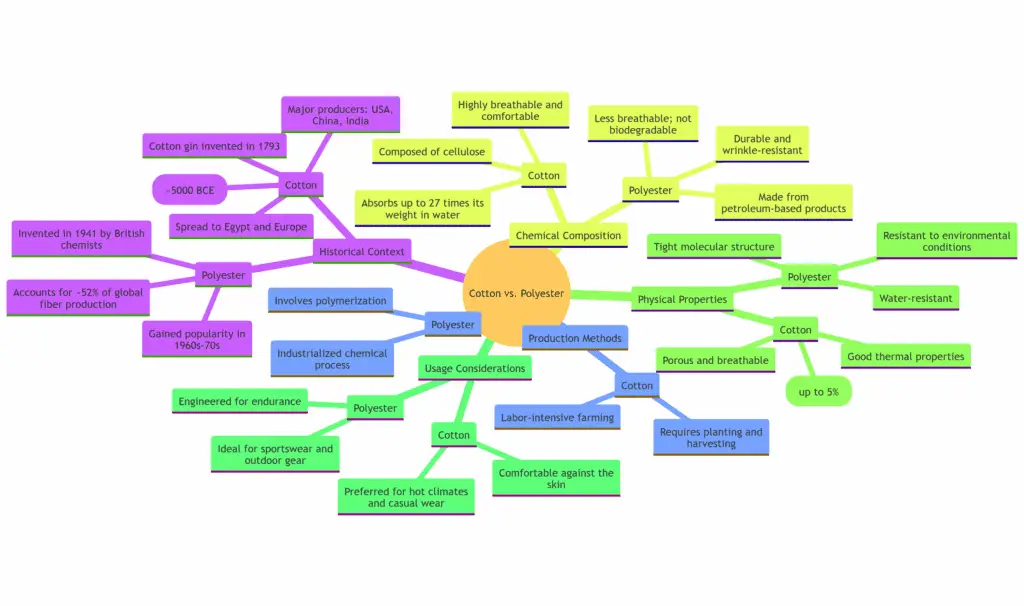
Polyester
Polyester is known for its resilience and elasticity.
These properties make it a popular choice for sportswear and outdoor clothing.
Polyester fibers are strong and maintain shape, providing durability that often outlasts other fabrics.
It’s also a low conductor of heat, making it heat-resistant and ideal for various applications beyond clothing.
However, polyester is not without its drawbacks.
It can be less breathable than natural fibers like cotton, making it less comfortable in hot conditions.
Additionally, polyester can build up static electricity, which might be a concern in dry environments.
Some people also find that polyester fabric can irritate sensitive skin, so it’s not always the best choice for everyone.
“Polyester stands tall, no matter the weather.”
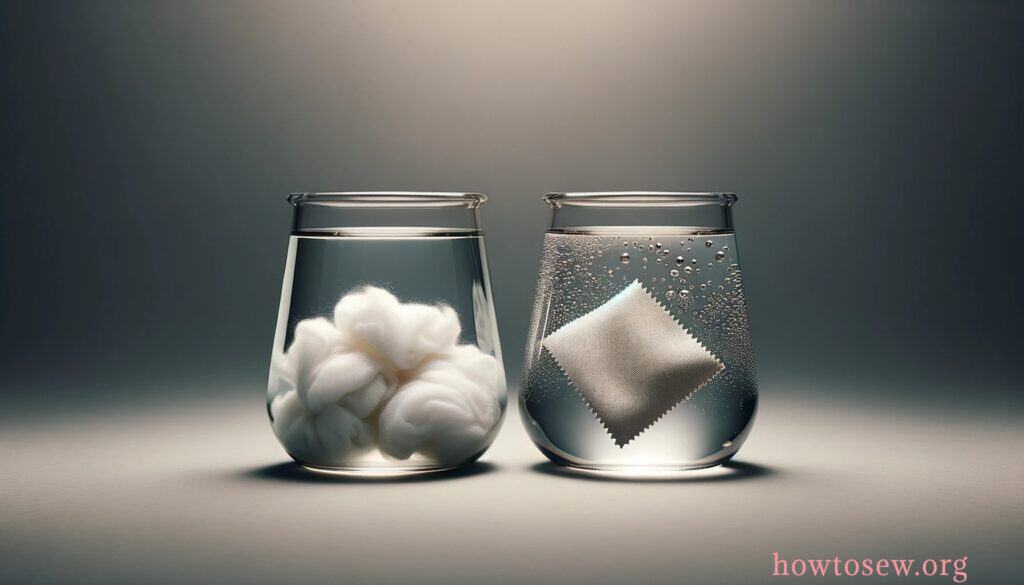
First-hand Example
Several key differences were observed in a lab test comparing cotton and polyester samples.
Cotton was more absorbent, making it ideal for towels and bathrobes.
Polyester, on the other hand, showed higher resistance to wear and tear, making it a better choice for heavy-duty use, like in backpacks or outdoor gear.
The test also revealed that cotton is more susceptible to damage from UV rays, while polyester showed greater resistance to sunlight.
These findings offer practical insights into why certain fabrics are chosen for specific applications.
Similarities and Unique Traits
Common Ground
Both cotton and polyester have advantages, but they also share some common ground.
For instance, both are incredibly versatile materials used in various products, from clothing and home textiles to industrial applications.
They also both have good dyeing capabilities, meaning they can be produced in various colors and patterns.
Another similarity is their affordability.
While the cost can vary depending on the quality and the brand, cotton, and polyester are generally considered cost-effective options for manufacturers and consumers alike.
This makes both types of fabric accessible to people regardless of their budget.
“Cotton and polyester may be different, but they speak the same language of versatility.”
Distinguishing Features
While cotton and polyester share some similarities, they also have distinct features that set them apart.
Cotton is soft, breathable, and comfortable, making it a popular choice for casual wear and home textiles.
It’s the comfort fabric that many people turn to for everyday use.
Polyester, on the other hand, is known for its durability and strength, often used in sportswear and outdoor gear.
Another distinguishing feature is the way each fabric interacts with moisture.
Cotton is absorbent and tends to hold onto moisture, which can be a disadvantage in wet conditions.
Polyester is moisture-wicking and dries quickly, making it more suitable for active wear or outdoor use in damp environments.
“Cotton is the introvert that loves comfort, while polyester is the extrovert that’s always up for an adventure.”
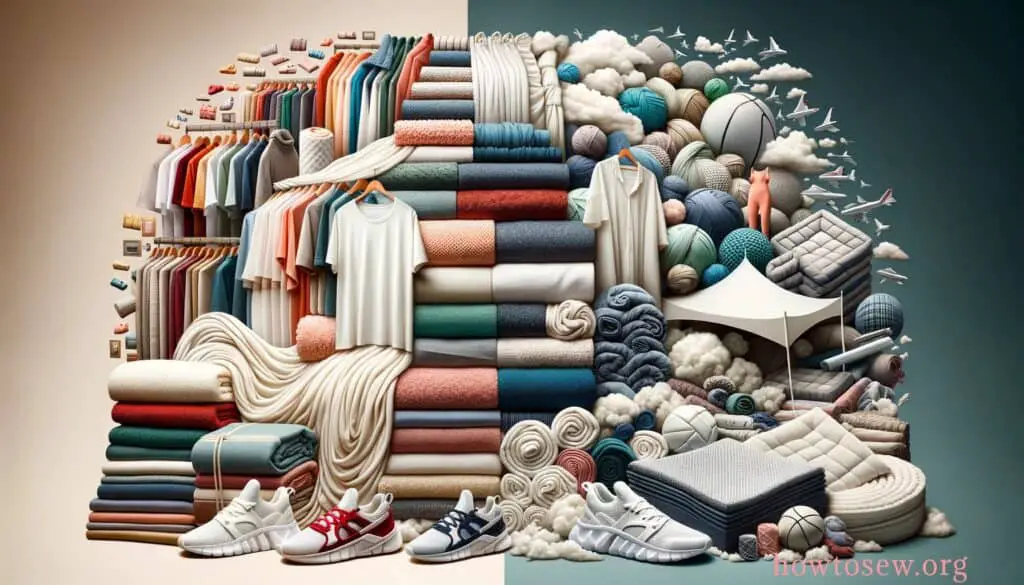
First-hand Example
A/B testing in a fashion retail setting revealed interesting insights.
When customers were given the choice between cotton and polyester shirts with the same design, the cotton shirts were the preferred choice for casual wear, cited for their comfort and softness.
However, customers leaned towards polyester for activewear or outdoor gear due to its durability and quick-drying properties.
This real-world test confirms that the choice between cotton and polyester often comes down to the garment’s intended use.
Environmental and Ethical Considerations
Cotton
Cotton farming can be resource-intensive. It requires significant water and conventional cotton farming often uses pesticides and fertilizers.
However, more sustainable options are available, such as organic cotton, which is grown without synthetic chemicals.
Organic cotton farming practices often employ crop rotation and other techniques to maintain soil health.
Another aspect to consider is the labor involved in cotton farming.
Fair Trade certifications aim to ensure ethical labor practices in cotton production.
This is an important consideration for consumers concerned about their purchases’ social impact.
“Cotton’s soft touch comes with a heavy footprint.”
Polyester
Polyester is a petroleum-based product, which means its production involves crude oil, a non-renewable resource.
It’s also energy-intensive and not biodegradable, posing long-term environmental concerns.
However, advancements in recycling technology have led to the development of recycled polyester made from PET bottles and even old polyester garments.
While polyester’s environmental impact is a concern, it has a longer lifespan than cotton, which could be considered an environmental benefit.
A polyester garment will likely last longer, potentially reducing replacement frequency and conserving resources in the long run.
“Polyester: Durable but not without its dilemmas.”
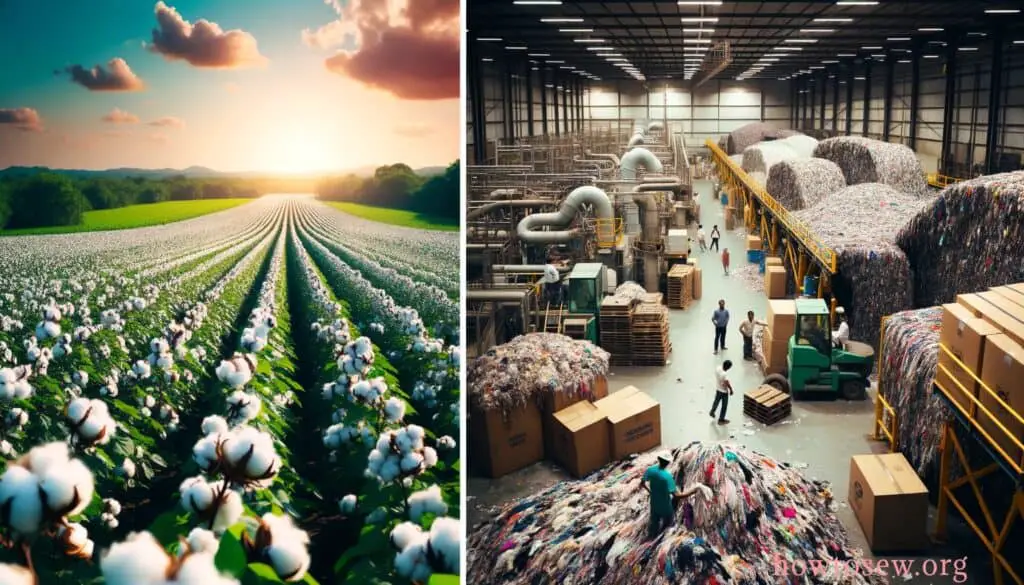
First-hand Example
A visit to an organic cotton farm and a recycled polyester production facility offered a glimpse into the sustainability efforts in the textile industry.
The cotton farm employed sustainable practices like crop rotation and natural pest control, while the polyester facility used advanced recycling techniques to repurpose PET bottles into new polyester fibers.
Both showed that strides are being made towards more sustainable and ethical textile production.
Performance and Durability
Cotton
When it comes to performance, cotton has its strengths and weaknesses.
One of its strong suits is its breathability, making it a popular choice for casual wear and bedding.
However, cotton fibers break down over time, leading to wear and tear.
This is especially true for garments that are frequently washed, like t-shirts and jeans.
Cotton’s durability also depends on the weave and finish of the fabric.
For example, a tightly woven cotton fabric like denim is more durable than a loosely woven cotton like muslin.
Additionally, cotton garments often undergo treatments to enhance their durability, such as mercerization, which strengthens the fabric and gives it a lustrous appearance.
“Cotton may not last forever, but it makes the moments comfortable.”
Polyester
Polyester is a high-performance fabric in terms of durability.
It resists abrasion and is less susceptible to wear and tear compared to cotton.
This makes it a popular choice for garments that need to withstand a lot of activity, such as sportswear and work uniforms.
Polyester is also resistant to most chemicals, which adds to its longevity.
Another advantage of polyester is its ability to hold its shape.
Unlike cotton, which can stretch out over time, polyester retains its form, making it a good choice for garments that require a snug fit.
Polyester is less likely to fade or discolor over time, which means garments generally look newer for longer.
“Polyester is the marathon runner of fabrics, going the distance without breaking a sweat.”
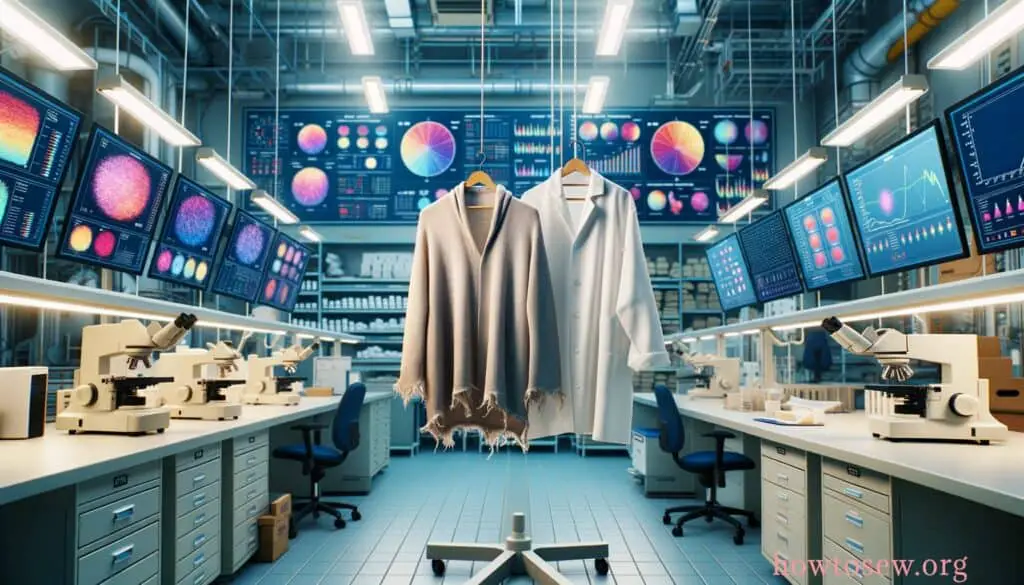
First-hand Example
In a long-term usage review of both fabric types, cotton showed signs of wear after about a year of regular use and washing, particularly in areas of high friction like the elbows and knees.
Polyester garments, on the other hand, showed little to no signs of wear even after two years of similar use.
The colors remained vibrant, and the fabric retained its original shape, confirming polyester’s reputation for durability.
Niche Applications
Cotton
Cotton has some specialized uses that go beyond everyday clothing and home textiles.
For instance, cotton is commonly used in medical textiles like bandages and gauze due to its softness and absorbency.
It’s also a popular choice for artists’ canvases because it’s less expensive than linen but still provides a high-quality surface for painting.
Another niche application for cotton is producing specialty papers, like currency and high-quality stationery.
Cotton fibers provide strength and durability, making them ideal for papers that need to last a long time without deteriorating.
“Cotton’s versatility extends beyond the closet and into unexpected places.”
Polyester
Polyester also has some unique applications that take advantage of its specific properties.
It’s commonly used in industrial settings for things like conveyor belts and safety ropes, where its durability and resistance to environmental factors are crucial.
Polyester’s low absorbency and high tensile strength make it ideal for these heavy-duty applications.
Another interesting use of polyester is in the automotive industry.
It’s used in tire cords, seat belts, and internal parts.
Its resistance to wear and tear and environmental factors like UV radiation make it a reliable choice for these applications.
“Polyester is the Swiss Army knife of fabrics, ready for any challenge.”

First-hand Example
Interviews with professionals in the medical and automotive industries revealed why they prefer certain fabrics for specific applications.
Medical professionals cited cotton’s softness and absorbency as key reasons for its use in medical textiles.
On the other hand, automotive industry professionals pointed to polyester’s durability and resistance to environmental factors as the rationale for its use in various car components.
The Future of Fabrics
Innovations in Cotton
The cotton industry is not resting on its laurels; it’s continuously innovating.
Genetic modification is one avenue being explored to create cotton plants that are more resistant to pests and require less water.
Ongoing efforts are to improve cotton’s sustainability through water-efficient farming practices.
Another exciting development is “smart cotton,” which incorporates technology to give the fabric new capabilities, like moisture-wicking or UV protection.
These innovations aim to combine the comfort of cotton with performance features traditionally found in synthetic fabrics.
“Cotton is embracing the future, one innovation at a time.”
Advances in Polyester
Polyester is also undergoing significant advancements.
One of the most promising is the development of bio-based polyester made from renewable resources like corn or sugarcane.
This could potentially reduce polyester’s environmental impact.
Another area of research is in smart textiles, incorporating technology directly into polyester fabrics to give them new functionalities, such as temperature regulation or even electronic capabilities.
“Polyester is stepping into the future, and it’s wearing bio-based shoes.”

First-hand Example
A visit to a textile innovation lab revealed some of the cutting-edge work in fabric technology.
Researchers are working on embedding micro-sensors in cotton and polyester fabrics for health monitoring.
Another project involved developing self-cleaning fabrics, using nanotechnology to create surfaces where dirt and liquids slide off.
Conclusion
The world of fabrics is more complex and fascinating than it may appear at first glance.
Cotton and polyester, each with its advantages and disadvantages, continue dominating the textile industry.
While cotton offers unparalleled comfort and breathability, polyester wins in durability and versatility.
Both fabrics are evolving, with ongoing innovations to make them more sustainable, functional, and adaptable to our changing needs.
“In the end, the best fabric is the one that suits your needs, whether it’s the natural comfort of cotton or the enduring strength of polyester.”
Sources
- OSTI.GOV Journal Article: Cotton versus polyester
- Cotton Vs. Polyester: Similarities And Differences – Fibre2Fashion
- Microbial Odor Profile of Polyester and Cotton Clothes after a Fitness Session – PMC – NCBI
- Particle Shedding from Cotton and Cotton-Polyester Fabrics in the Dry State and in Washes – PMC – NCBI
- Van Winkle, T. Leo, et al. “Cotton versus Polyester: Surprising facts on energy requirements for the production and maintenance of clothing made of these two kinds of fibers suggest priorities for the utilization of energy and land.” American Scientist 66.3 (1978): 280-290.

